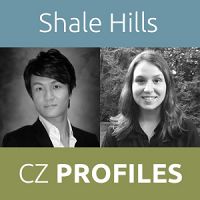Critical Zone Profile – LILLIAN HILL (ecologist, graduate student)
26 Sep 2016
Graduate student, Department of Ecosystem Science and Management, Pennsylvania State University
Lily Hill grew up in the forested mountains of West Virginia where she developed a love for nature and environmental science. She completed her B.S. in Biology at West Virginia University in 2014. Hill is currently a Masters student in ecology with a minor in biogeochemistry at Penn State University. She works at the Susquehanna Shale Hills Critical Zone Observatory (CZO) investigating the imprint of biota on acid- and redox-weathering and nutrient cycling between bedrock, soil and biota.
“My work is just a piece of the puzzle of how nutrients cycle through our ecosystems and how they interact.” – Lillian Hill
One goal of my work is to understand how nutrients in bedrock weather into the soil profile and then cycle between soil and biota. I investigate both soil and leaf nutrient concentrations in shale and sandstone geology. My other goal focuses on carbon dioxide and oxygen concentrations through the soil profile to increase the understanding of weathering reactions and microbial activity. We measure soil gases throughout the soil profile and at varying topographical locations in Shale Hills and Garner Run catchments.
Terrestrial carbon, nitrogen and phosphorus cycles are closely tied though the interactions of bedrock, soil and biota. Looking at the soil and plant nutrient concentrations, we are able to estimate what is being provided to soil from bedrock weathering. Gaining insight into the roles that bedrock, soil and biota play in nutrient cycles, provides the knowledge needed to properly combat related issues, especially with perturbations from climate change and human land use.
The CZO network’s invaluable multi-disciplinary based approach provides the knowledge required to understand the complex interactions of a catchment.
The Critical Zone (CZ) is where life happens. Interactions that build and maintain ecosystems all meet in the CZ. The CZO network’s invaluable multi-disciplinary based approach provides the knowledge required to understand the complex interactions of a catchment. With an interdisciplinary team, we are able to investigate, in depth, the processes occurring within this zone. By using common measurements taken within the CZOs and building models based on found catchment dynamics, we can better predict how the CZ will response to changes. The ability to ‘earthcast’ is what is driving each of the disciplines.
CZO scientists tackle same questions with different knowledge and discuss the diverse approaches to answer them. This effort increases our ability to explain our hypotheses and contribute to those outside of our field. The CZ approach to research has grown internationally and allows teams to look at processes occurring worldwide.
Each CZO plays a role in developing our knowledge of how the CZ forms and maintains itself. By investigating weathering across many physiographic environments and over long time-scales, we are able to model processes and how they affect the pathways of nutrients and water. We can then scale up that knowledge to natural resources around the world. By coordinating measurements and questions across the network, we see how the CZ is affected by the society’s use of natural resources and what the repercussions of management decisions will be.
Lillian Hill, Penn State
Lillian working at the Shale Hills CZO
News Category:
PEOPLE
Related News
Explore Further






